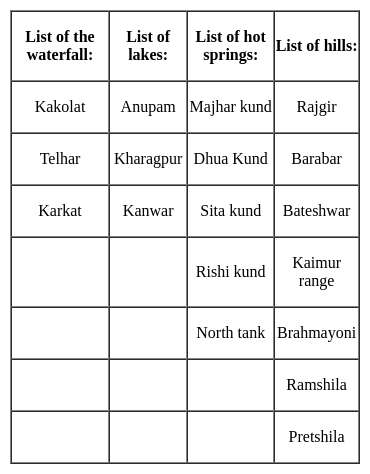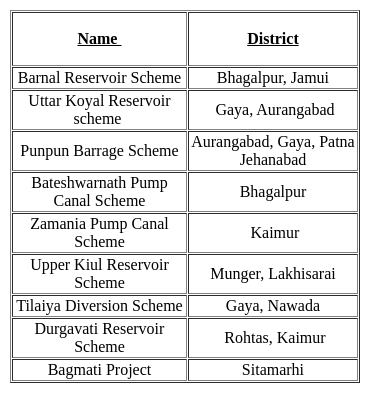Software Development Exam > Software Development Tests > Test: Bihar Specific (Physiographic Division of Bihar) - Software Development MCQ
Test: Bihar Specific (Physiographic Division of Bihar) - Software Development MCQ
Test Description
10 Questions MCQ Test - Test: Bihar Specific (Physiographic Division of Bihar)
Test: Bihar Specific (Physiographic Division of Bihar) for Software Development 2025 is part of Software Development preparation. The Test: Bihar Specific (Physiographic Division of Bihar) questions and answers have been prepared
according to the Software Development exam syllabus.The Test: Bihar Specific (Physiographic Division of Bihar) MCQs are made for Software Development 2025 Exam.
Find important definitions, questions, notes, meanings, examples, exercises, MCQs and online tests for Test: Bihar Specific (Physiographic Division of Bihar) below.
Solutions of Test: Bihar Specific (Physiographic Division of Bihar) questions in English are available as part of our course for Software Development & Test: Bihar Specific (Physiographic Division of Bihar) solutions in
Hindi for Software Development course.
Download more important topics, notes, lectures and mock test series for Software Development Exam by signing up for free. Attempt Test: Bihar Specific (Physiographic Division of Bihar) | 10 questions in 20 minutes | Mock test for Software Development preparation | Free important questions MCQ to study for Software Development Exam | Download free PDF with solutions
Test: Bihar Specific (Physiographic Division of Bihar) - Question 1
Which of the following is known as the Sorrow of Bihar?
Detailed Solution for Test: Bihar Specific (Physiographic Division of Bihar) - Question 1
Test: Bihar Specific (Physiographic Division of Bihar) - Question 2
Which is not part of physiological division of Bihar?
Detailed Solution for Test: Bihar Specific (Physiographic Division of Bihar) - Question 2
Test: Bihar Specific (Physiographic Division of Bihar) - Question 3
Which of the following statements is true about the Kosi Multipurpose Project -
I. This is a joint project between India and Nepal.
II. The main objective of this project is flood control, irrigation, and land conservation.
III. This project is mainly divided into 3 parts
Detailed Solution for Test: Bihar Specific (Physiographic Division of Bihar) - Question 3
Test: Bihar Specific (Physiographic Division of Bihar) - Question 4
Which of the following is the hills of Bihar?
Detailed Solution for Test: Bihar Specific (Physiographic Division of Bihar) - Question 4
Test: Bihar Specific (Physiographic Division of Bihar) - Question 5
Which of the following statements is true about the Tamasin Falls -
I. This waterfall is on the river Mahane
II. The height of this waterfall is about 50 feet
III. This waterfall is located on the border of Bihar and Jharkhand
I. This waterfall is on the river Mahane
II. The height of this waterfall is about 50 feet
III. This waterfall is located on the border of Bihar and Jharkhand
Detailed Solution for Test: Bihar Specific (Physiographic Division of Bihar) - Question 5
Test: Bihar Specific (Physiographic Division of Bihar) - Question 6
Which of the following waterway passes through Bihar?
Detailed Solution for Test: Bihar Specific (Physiographic Division of Bihar) - Question 6
Test: Bihar Specific (Physiographic Division of Bihar) - Question 7
Which of the following statements is true -
I. Shivhar is a district with minimum forest area of Bihar.
II. Kaimur is the most forested district of Bihar
I. Shivhar is a district with minimum forest area of Bihar.
II. Kaimur is the most forested district of Bihar
Detailed Solution for Test: Bihar Specific (Physiographic Division of Bihar) - Question 7
Test: Bihar Specific (Physiographic Division of Bihar) - Question 8
Which of the following irrigation projects is related to Bihar -
I. Punpun barrage scheme
II. North Koel Reservoir Scheme
III. Zamania Pump Canal Scheme
IV. Tilaiya diversion reservoir scheme
I. Punpun barrage scheme
II. North Koel Reservoir Scheme
III. Zamania Pump Canal Scheme
IV. Tilaiya diversion reservoir scheme
Detailed Solution for Test: Bihar Specific (Physiographic Division of Bihar) - Question 8
Test: Bihar Specific (Physiographic Division of Bihar) - Question 9
Which of the following districts of Bihar is irrigated by the western Kosi canal system?
I. Madhubani
II. Darbhanga
III. Muzaffarpur
IV. Sarhasa
V. Purnia
I. Madhubani
II. Darbhanga
III. Muzaffarpur
IV. Sarhasa
V. Purnia
Detailed Solution for Test: Bihar Specific (Physiographic Division of Bihar) - Question 9
Test: Bihar Specific (Physiographic Division of Bihar) - Question 10
Which of the following district of Bihar is listed among the gold mineral producing places?
Detailed Solution for Test: Bihar Specific (Physiographic Division of Bihar) - Question 10
Information about Test: Bihar Specific (Physiographic Division of Bihar) Page
In this test you can find the Exam questions for Test: Bihar Specific (Physiographic Division of Bihar) solved & explained in the simplest way possible.
Besides giving Questions and answers for Test: Bihar Specific (Physiographic Division of Bihar), EduRev gives you an ample number of Online tests for practice
Download as PDF





















